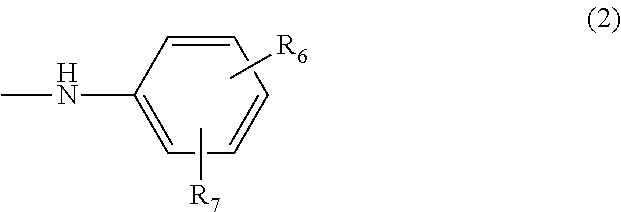Azo Compound And Salts Thereof, As Well As Dye-Based Polarization Films And Polarizing Plates Comprising The Same
a technology of azo compounds and salts, applied in the field of new dyes, can solve the problems of insufficient heat resistance, insufficient light resistance, insufficient heat resistance, etc., and achieve the effects of excellent light resistance, high polarization performance and durability
- Summary
- Abstract
- Description
- Claims
- Application Information
AI Technical Summary
Benefits of technology
Problems solved by technology
Method used
Image
Examples
example 1
[0074]7-Amino-3-(3-sulfopropoxy)naphthalene-1-sulfonic acid (36.1 parts) was added to water (500 parts), dissolved with sodium hydroxide and cooled. 35% hydrochloric acid (32 parts) was added at 10° C. or less and then, sodium nitrite (6.9 parts) was added and the resultant mixture was stirred at 5 to 10° C. for one hour. To this, a solution containing 2,5-dimethylaniline (12.1 parts) dissolved in a diluted aqueous solution of hydrochloric acid was added and sodium carbonate was added while stirring at 10 to 30° C. to adjust pH to 3. The resultant mixture was further stirred to complete a coupling reaction and filtrated to obtain the monoazo compound (44.3 parts) represented by Formula (26) below.
[0075]To the resultant monoazo compound, 35% hydrochloric acid (32 parts), and then, sodium nitrite (6.9 parts) were added and the resultant mixture was stirred at 25 to 30° C. for 2 hours to perform diazotization. On the other hand, 6-(4′-methoxyphenyl)amino-1-naphthol-3-sulfonic acid (31....
example 2
[0076]7-Amino-3-(3-sulfopropoxy)naphthalene-1-sulfonic acid (36.1 parts) was added to water (500 parts), dissolved with sodium hydroxide and cooled. 35% hydrochloric acid (32 parts) was added at 10° C. or less and then, sodium nitrite (6.9 parts) was added and the resultant mixture was stirred at 5 to 10° C. for one hour. To this, a solution containing sodium anilinomethanesulfonate (20.9 parts) dissolved in water was added and sodium carbonate was added while stirring at 10 to 30° C. to adjust pH to 3. The resultant mixture was further stirred to complete a coupling reaction. Thereafter sodium hydroxide was added to perform hydrolysis at 80° C. and a monoazo compound precipitated was filtrated to obtain the compound (37.2 parts) represented by Formula (27) below.
[0077]To the resultant monoazo compound, diazotization, coupling and crystallization were performed in the same manner as in Example 1 to obtain the disazo compound (46.0 parts) represented by Formula (7) above. The maximum...
example 3
[0078]6-(4′-Methoxyphenyl)amino-1-naphthol-3-sulfonic acid (31.0 parts) was added to water (200 parts) and rendered to a weak alkaline solution with sodium carbonate. To the solution, the monoazo compound of Formula (27) above was poured in the same manner as in Example 2 while maintaining a diazo compound at pH 8 to 10 and the resultant mixture was stirred to complete a coupling reaction. In the solution, salting out was performed with sodium chloride and filtration was performed to obtain a compound (40 parts) of Formula (8) above. The maximum absorption wavelength of this compound in a 20% aqueous pyridine solution was 534 nm.
PUM
| Property | Measurement | Unit |
|---|---|---|
| Transparency | aaaaa | aaaaa |
Abstract
Description
Claims
Application Information
 Login to View More
Login to View More - R&D
- Intellectual Property
- Life Sciences
- Materials
- Tech Scout
- Unparalleled Data Quality
- Higher Quality Content
- 60% Fewer Hallucinations
Browse by: Latest US Patents, China's latest patents, Technical Efficacy Thesaurus, Application Domain, Technology Topic, Popular Technical Reports.
© 2025 PatSnap. All rights reserved.Legal|Privacy policy|Modern Slavery Act Transparency Statement|Sitemap|About US| Contact US: help@patsnap.com



